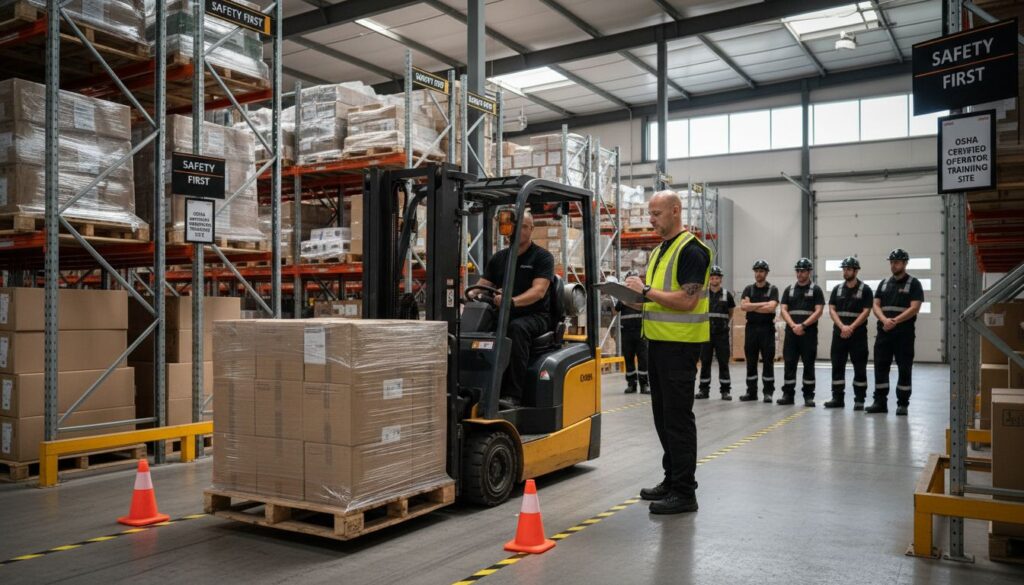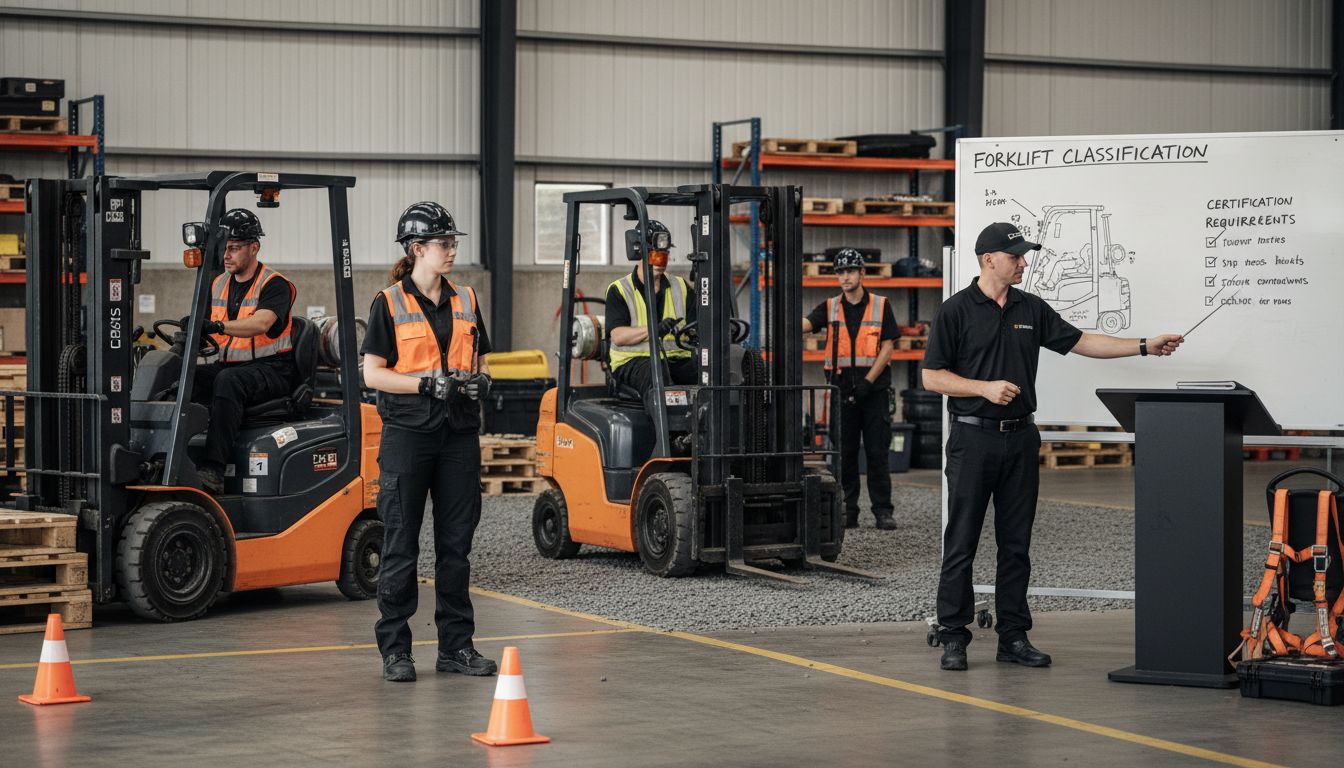
Nearly one in four workplace accidents involve improper use of industrial equipment like forklifts, making operator qualification a critical concern for every employer. In fast-paced environments, even a small mistake can lead to costly injuries or damage. Understanding what defines a qualified forklift operator helps workplaces prevent risk, meet legal requirements, and ensure smooth daily operations. This guide clarifies standards, requirements, and best practices for anyone responsible for safe material handling.
| Point | Details |
|---|---|
| Forklift Operator Qualification | Operators must pass a comprehensive evaluation that includes theoretical knowledge, practical skills, and safety protocols to ensure workplace safety. |
| Types of Certifications | Various certification categories exist, each requiring specific skills, enhancing operator versatility across different equipment. |
| OSHA Compliance | Adhering to OSHA regulations is essential for legal compliance, involving regular training and performance assessments to maintain safety standards. |
| Employer Responsibilities | Employers must ensure ongoing training and re-certification for operators, fostering a proactive culture of safety and continuous improvement. |
Forklift operator qualification represents a critical safety standard designed to ensure workplace safety and operational competence. These comprehensive standards establish precise requirements for individuals seeking to operate industrial machinery, focusing on technical skills, safety protocols, and demonstrable professional capabilities. According to TESDA, forklift operator qualification encompasses a holistic assessment of an individual’s ability to handle materials safely and efficiently across various industrial environments.
The qualification process typically involves several key components that evaluate an operator’s comprehensive skill set. These components include:
According to NZQA, professional standards recommend periodic re-certification and refresher training every three years to maintain operator competency. This approach ensures that operators remain updated on the latest safety protocols, technological advancements, and industry best practices. Forklift Operator Requirements 2025 highlights that continuous learning is fundamental to maintaining high safety and performance standards.
The qualification standards also emphasize rigorous assessment methodologies that evaluate both theoretical understanding and practical application. Operators must demonstrate proficiency in critical areas such as load management, spatial awareness, equipment inspection, and emergency response procedures. By establishing these comprehensive qualification standards, industries can significantly reduce workplace accidents, optimize operational efficiency, and create a culture of safety and professional excellence.
Forklift certifications are specialized credentials that validate an operator’s ability to safely and professionally manage industrial machinery across diverse workplace environments. NCCER identifies several distinct certification types that cover various operational scenarios and equipment specifications, ensuring comprehensive competency assessment for professionals in material handling industries.
The primary forklift certification categories typically include:
According to ASDC, each certification type requires specific skill sets and involves unique operational parameters. Professionals seeking comprehensive career development can explore types of forklift certifications to understand the nuanced requirements for different machinery and industrial contexts.
The certification process involves rigorous theoretical and practical assessments that evaluate an operator’s technical knowledge, safety awareness, and practical skills. These evaluations typically include comprehensive examinations covering equipment mechanics, workplace safety protocols, load management techniques, and emergency response procedures. By obtaining multiple certification types, forklift operators can significantly enhance their professional versatility, employability, and potential for career advancement across various industrial sectors.

OSHA compliance represents a critical framework for ensuring workplace safety and operational standards in industrial environments, particularly for forklift operators. NCCER emphasizes that legal compliance involves comprehensive assessments of operator skills, safety protocols, and equipment management procedures. These regulations are designed to minimize workplace accidents, protect worker safety, and establish clear operational guidelines for industrial machinery handling.
The key OSHA requirements for forklift operators typically encompass several critical components:
According to Wikipedia, OSHA regulations like 29 CFR 1926 mandate formal certification processes that ensure operators meet rigorous professional standards. Businesses can explore OSHA compliance guidelines to develop comprehensive training programs that align with these critical legal requirements.
The legal compliance process extends beyond initial certification, requiring continuous professional development and periodic skill reassessment. Operators must demonstrate ongoing competence through regular training updates, equipment familiarity checks, and adherence to evolving safety standards. By maintaining strict compliance with OSHA regulations, organizations can create safer work environments, reduce potential legal liabilities, and protect both employees and operational infrastructure from potential workplace incidents.

The forklift certification and evaluation process represents a comprehensive assessment designed to validate an operator’s technical competence, safety awareness, and practical skills. NCCER outlines a rigorous two-part evaluation framework that includes a two-hour closed-book examination and a hands-on performance verification, ensuring operators meet stringent industry standards for safe equipment operation.
The certification process typically involves multiple critical stages:
TESDA emphasizes the importance of comprehensive curriculum design and systematic training delivery in preparing operators for certification. Professionals seeking detailed insights can explore how forklift certification works to understand the nuanced requirements of this critical professional qualification process.
The evaluation process goes beyond simple technical proficiency, assessing an operator’s holistic understanding of workplace safety, equipment maintenance, and operational protocols. Candidates must demonstrate not only their ability to operate machinery but also their comprehension of risk management, emergency procedures, and industry-specific safety standards. This multifaceted approach ensures that certified forklift operators are well-equipped to navigate complex industrial environments while maintaining the highest levels of safety and professional competence.
Forklift operation involves numerous potential risks that can be mitigated through awareness and proactive safety practices. NZQA identifies several critical operational errors that frequently compromise workplace safety, highlighting the importance of understanding and preventing common mistakes that can lead to significant accidents and equipment damage.
The most prevalent forklift operational mistakes include:
TESDA emphasizes that many operational errors stem from insufficient training and lack of consistent safety awareness. Operators can explore essential tips for avoiding forklift accidents to develop a comprehensive understanding of best practices and risk mitigation strategies.
Preventing these common mistakes requires a multifaceted approach that combines continuous education, rigorous self-assessment, and a commitment to maintaining high safety standards. Successful forklift operators must develop a proactive mindset, constantly evaluating their environment, equipment condition, and personal performance. By implementing systematic pre-operation checks, maintaining situational awareness, and consistently following established safety protocols, operators can significantly reduce the likelihood of workplace incidents and create a safer, more efficient operational environment.
Employer responsibilities in forklift operator management extend far beyond initial hiring and certification, encompassing a comprehensive framework of continuous safety oversight and professional development. NZQA emphasizes that employers must ensure operators maintain valid certifications and participate in mandatory refresher training every three years to preserve operational competency and workplace safety standards.
Key employer responsibilities include:
TESDA highlights that effective ongoing training involves more than periodic assessments. Employers can leverage key points to ensure compliance with OSHA forklift training safety standards to develop robust training infrastructures that prioritize operator safety and organizational risk management.
Successful ongoing training demands a proactive and dynamic approach that recognizes the evolving nature of workplace safety technologies and operational methodologies. Employers must create a culture of continuous learning, where operators are encouraged to enhance their skills, stay updated on the latest industry standards, and develop a deep understanding of equipment-specific safety protocols. By investing in comprehensive training programs and fostering a safety-first mindset, organizations can significantly reduce workplace accidents, improve operational efficiency, and demonstrate a genuine commitment to employee well-being.
Understanding forklift operator qualifications and OSHA standards is essential for protecting your workforce and ensuring compliance. This article highlights the challenges many face such as mastering safety protocols, maintaining certifications, and avoiding costly operational mistakes. If you want to ensure your team operates safely and confidently, comprehensive training that covers both theory and hands-on evaluation is critical.
Take control of your forklift safety and certification needs with proven solutions offered by Forklift Certification Archives.

Get started today at forkliftacademy.com where you can access OSHA-compliant courses designed for operators and employers alike. Whether you need individual certification, refresher training, or onsite business programs, take the next step now to reduce liability and build a culture of safety.
The key components of forklift operator qualification standards include theoretical knowledge of equipment mechanics, understanding of workplace safety regulations, practical operating skills demonstration, physical and cognitive fitness assessments, and technical proficiency with different forklift types.
Forklift operators should undergo re-certification and refresher training every three years to maintain their competency and stay updated on the latest safety protocols and industry best practices.
The main OSHA requirements for forklift operators include mandatory initial safety training, comprehensive written examinations, practical skills demonstration, periodic performance evaluations, equipment-specific operational certifications, regular refresher training sessions, and proper documentation of operator qualifications.
Common operational mistakes include skipping pre-operation equipment inspections, improper load handling, failing to maintain proper visibility, exceeding speed limits, and ignoring safety protocols. These can be avoided through continuous education, self-assessment, and adherence to established safety practices.